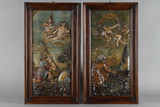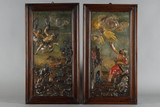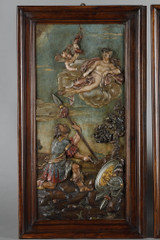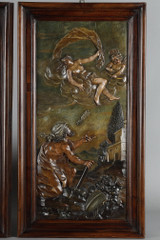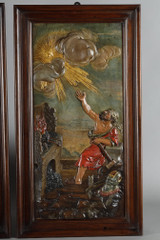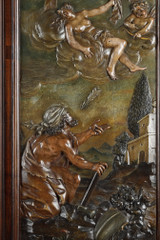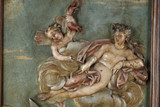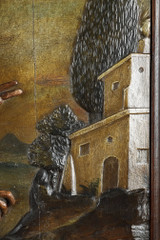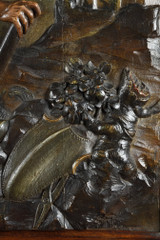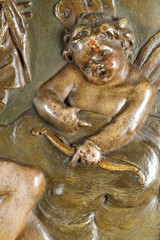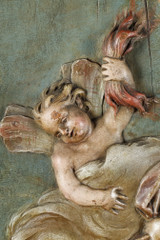A rare set of four polychrome, bas-relief carved linden wood panels illustrating mythological scenes, European work from the first half of the 18th century. These panels depict various mythological scenes related to the goddess Venus (Aphrodite). The polychromy features beautiful highlights, particularly in red and yellow, which enhance the narrative (the golden rays of the sun, the flames of the hearth, the gilded ornaments of the shield, etc.). Circa 1730.
The four scenes depicted evoke episodes
1. A group of naked female figures, floating in the air on a cloud, brandishing bundles of sticks, chase a man who is bowing under their power. The attributes of Venus, who is leading this offensive, can be recognized.
2. Venus is recognizable by the veil she holds aloft above her head at the end of her arm. She is accompanied by Cupid, who has just shot a love arrow at a man kneeling on the ground. This man, with long hair and a beard, wearing armor and holding a blacksmith's pair of tongs at his feet, is Vulcan/Hephaestus, Venus's husband. The iconography is faithful to Virgil's Aeneid, in the episode where Venus asks Vulcan to forge magnificent weapons for her son, Aeneas, who is about to found Rome.
3. Venus, once again floating in the air, this time in a semi-reclining pose draped in a sheet. She is accompanied by Lucifer, the angel to her left, brandishing a flame. At her feet, a warrior, kneeling, spear in hand, his gaze directed towards the Goddess, points to an array of weapons (a shield, a helmet adorned with two plumes, a spear, a sword). In another passage from the Aeneid, Venus appears radiant on the clouds, bearing the weapons promised to her son.
4. In this scene, we find Vulcan in his forge; on the left, the hearth is lit, with embers and flames visible, used to heat the blacksmiths' tools; on the right, an anvil on which Vulcan leans, holding a hammer; scattered on the ground are a breastplate, arrows, and a pair of tongs used to grip the pieces he works on. Vulcan, with his right arm raised towards the sky, addresses the sun, which is depicted with a face—the personified sun god, Helios. The artist is depicting here a passage from Homer's Odyssey.
Dimensions without frame: 74 x 35 cm
Condition report: Good condition, some cracks are present
- Reference :
- 3435
- Width :
- 47 (cm)
- Height :
- 86 (cm)
- Depth :
- 4 (cm)
- Era:
- 18th century
- Style:
- Ancient Rome and Greece
- Materials:
- Drink



